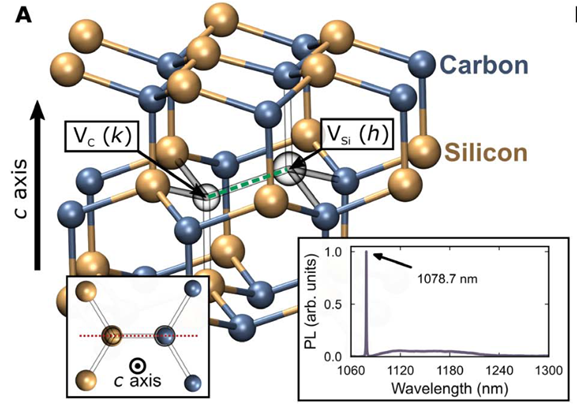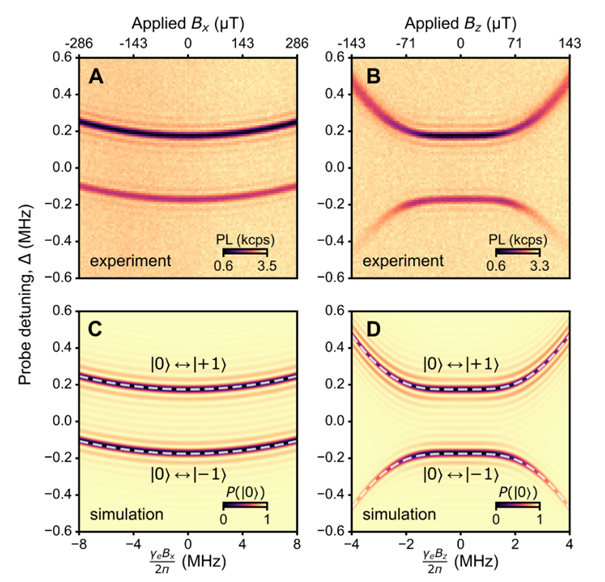An ongoing challenge for solid-state defect electronic spin systems is how to integrate them with other quantum systems through novel electromagnetic interactions or enhancing their spin coherence properties in their magnetic sublevels. These types of challenges require spin systems with unique properties when it comes to how they can couple to external fields.

One such system is the basal kh species of the neutral divacancy defect hosted in the 4H polytype of silicon carbide (SiC). The basal term comes from the fact it is composed of an adjacent vacancy of carbon and silicon atoms (A) that is oriented on the basal plane with respect to the c-axis in the SiC lattice. This orientation makes the kh divacancy a low symmetry system and bestows it a number of interesting properties as a spin qubit when coupled to AC electric and magnetic fields.


The low symmetry (C_1h, in the crystal symmetry notation) manifests in the spin system's ground-state spin sublevels as longitudinal and transverse zero-field splittings. This produces mixed spin states when the magnetic field near the defect is perfectly canceled. Near zero field in the z-axis direction, there now exists a clock transition characerized by parabolic instead of linear magnetic field energy field dependence (blue lines) compared to the axial species of divacancy defects. Thus, measuring spin coherence for a prepared state between the 0 state and one of the +/- states produces enhanced protection from magnetic noise due primarily to nuclear spins present in SiC. The 74 us T2* at 5 K is more than 30-fold times longer than an axial divacancy spin qubit measured in the same sample at zero magnetic field.

Now turning to a property of the excited state of this spin-1 system when coupling to AC electric fields, we see that upon driving the system with microwave frequency electric fields from nearby capacitive pads, the excited state magnetic sublevels can be driven to induce Landau-Zener-Stuckelberg (LZS) interference fringes in the resonant optical absorption spectrum of the basal divacancy. When the AC drive and the detuning is swept, the spin interacts with the electric fields while in the excited state, where the optical resonance either absorbs or emits quanta of energy. The fringes indicate the production of multiphoton resonances at laser detunings equal to integer multiples of the drive frequency, and match very well with theory.

Focusing now only on the magnetic sublevels of the basal divacancy ground state, we investigate what happens when an AC microwave dressing drive (red) is applied between the + and - states, at the same frequency as the transverse zero field splitting, which is measured precisely using Ramsey interferometry. The two states that made up the bare clock transition now undergo Autler-Townes splitting to form new dressed states +/-1, which are necessarily distinct from the bare m_s = +/-1 of a spin-1 system. This new pair of states act as a decoherence protected subspace (DPS) for a spin qubit prepared between any pair of the three levels that greatly enhances the protection from magnetic noise beyond that gained from the clock transistion mentioned above.

Considering how the magnetic energy levels change as a function of the magnetic field in all 3 axes, the way the DPS operates can be elucidated. Shown here are experimental plots of the spectrum of the transition frequency between the 0 state and the +/-1 states of the DPS as the z-axis (A) or x/y-axis (B) magnetic is changed. The extra term in the spin Hamiltonian from the dressing drive, when properly considered in the rotating wave approximation, gives first-order protection against fluctuations in the zero-field splitting, which protects the qubit from temperature and electrical noise. The spin does retain first-order sensitivites to the dressing drive magnitude, but what results are inhomogeneous dephasing times (T2*) over 10,000x better than divacancies found in the natural SiC crystal after using active feedback to stabilize the dressing drive.
Together, these two results utilizing the spin and optical properties of the basal divacancy in 4H-SiC describe a rich system to investigate interactions between defect spins and electromagnetic fields of other quantum systems. The observation of LZS interference in SiC spin defects could have applications with other quantum systems that utilize AC electric fields, such as superconducting qubits, trapped atoms, and circuit quantum electrodynamics. And the demonstration of a very long coherence time using a single dressing drive to place a single spin qubit inside a DPS could have applications in extending coherence in other similar quantum systems with clock transitions.
Details can be found in our manuscripts: